London 04: Deep calculation, London System and the Caro Kann Gambit!
There were three extremely interesting things that happened in the fourth round of the London Chess Classic. Vishy Anand made an impressive and deep calculation against Michael Adams, but couldn't assess the position correctly. Wesley So played a very interesting idea against the very popular London System and Hikaru Nakamura brought the 3...c5 gambit in the Caro Kann back into action. These games contain some great learning material and IM Sagar Shah makes sure that you absorb maximum value out of them.
Pictures by Lennart Ootes

One of the main reasons why the elite players are where they are, right at the very top, is because they always think about opponent's possibilities. This is something that average players are never able to achieve. Unlike the top players, they can never really think about the best moves for their opponents. But it's not some kind of rocket science. Chess is a game played between you and your opponent. Thinking about just your own moves is not enough. You also need to know what the man sitting opposite you wants to achieve. And when you start respecting his ideas as much as your own, you start to show a huge rise in your level of play. Let's learn this from the game of Vishy Anand.


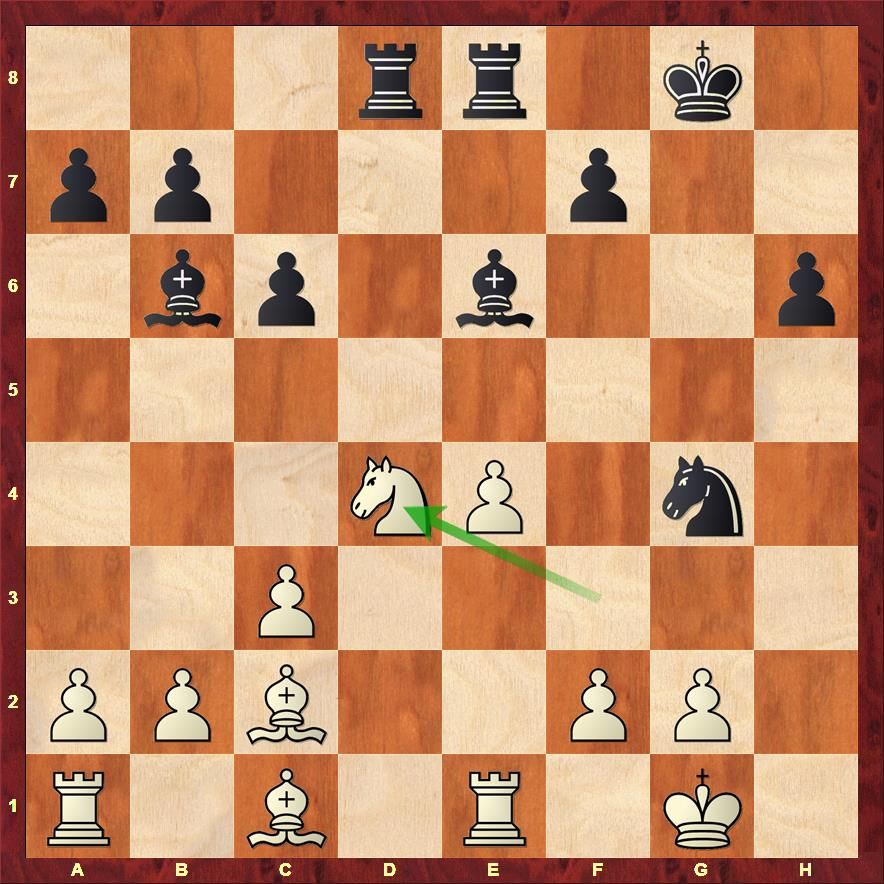

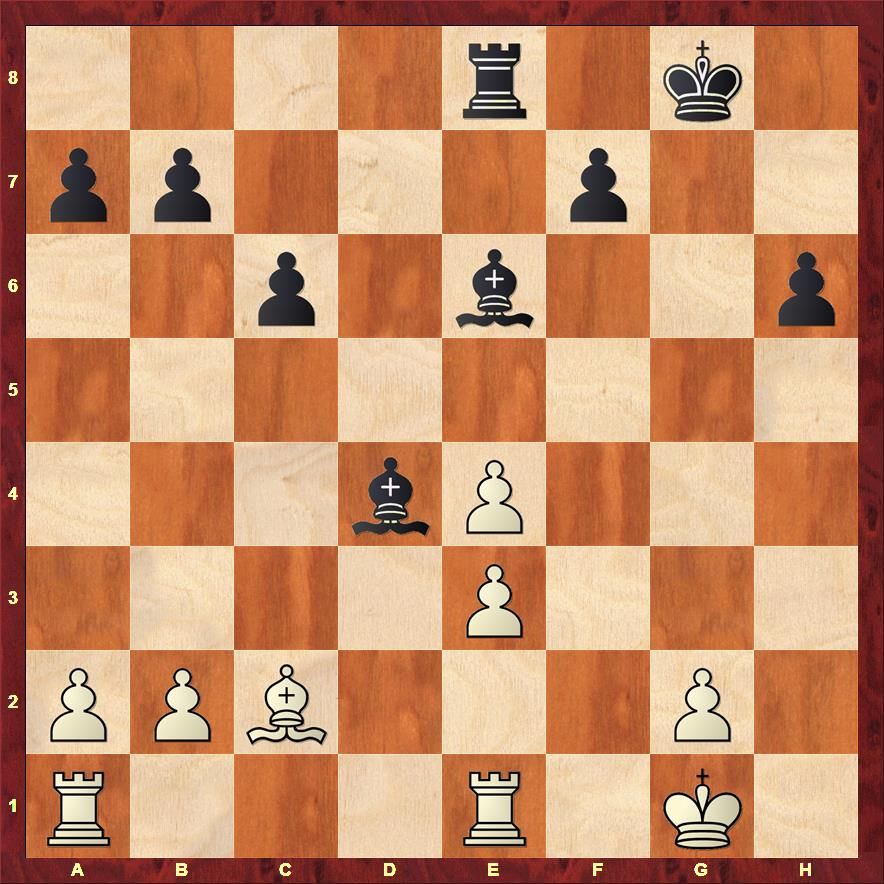
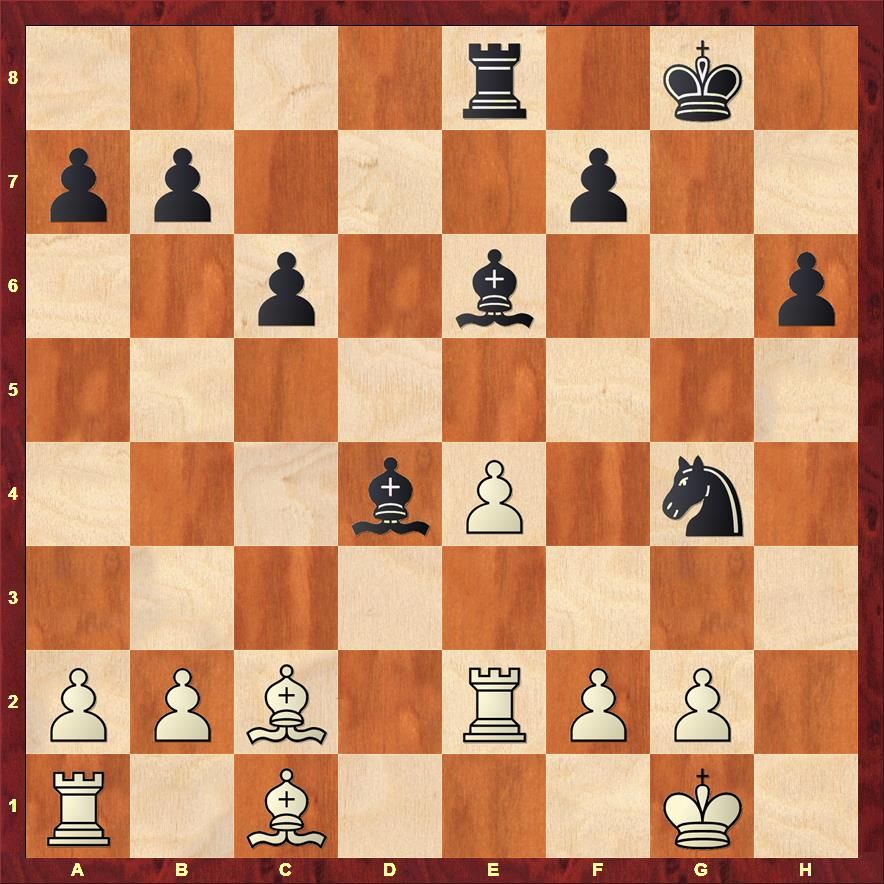

 One of the prime reasons why White is better here is because of his structure and the bishop pair. True the d4 pawn is dangerous, but right now d3 is not so good because of Bd1. White will slowly consolidate with f3 and have a pleasant position.
One of the prime reasons why White is better here is because of his structure and the bishop pair. True the d4 pawn is dangerous, but right now d3 is not so good because of Bd1. White will slowly consolidate with f3 and have a pleasant position.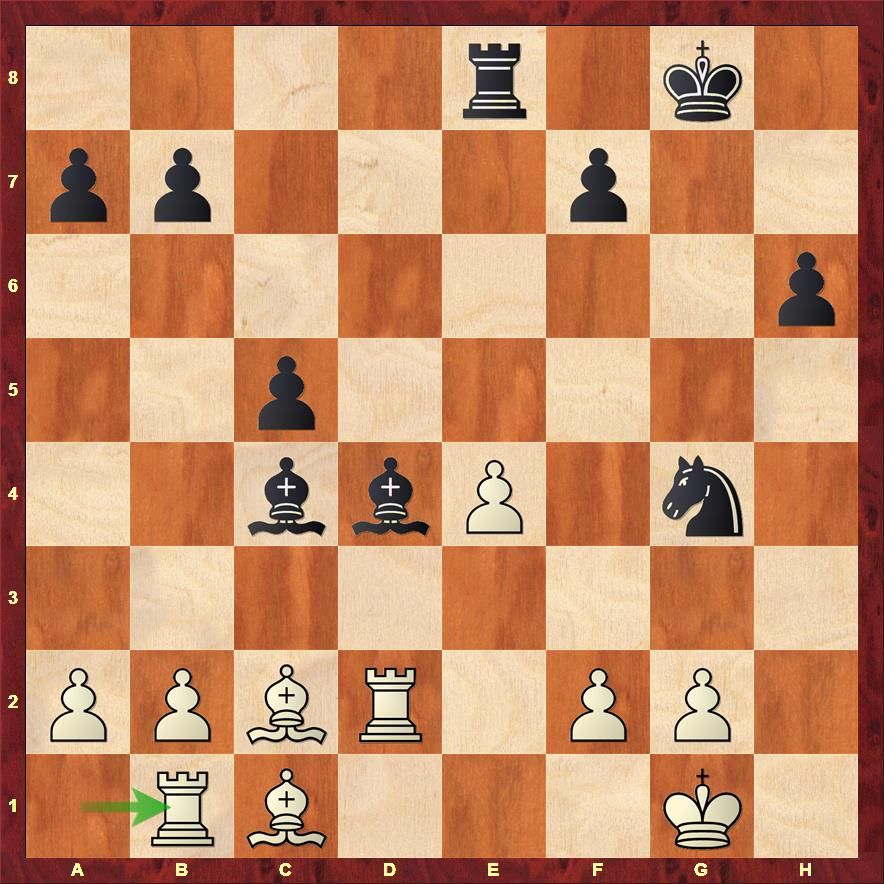
[Site "London"]
[Date "2016.12.12"]
[Round "4"]
[White "Anand, Viswanathan"]
[Black "Adams, Michael"]
[Result "1/2-1/2"]
[ECO "C54"]
[WhiteElo "2779"]
[BlackElo "2748"]
[Annotator "Sagar Shah"]
[PlyCount "63"]
[EventDate "2016.??.??"]
[EventType "tourn"]
[EventCountry "ENG"]
[SourceTitle "playchess.com"]
[Source "ChessBase"]
Ne7 9. Bb3 Ng6 10. d4 Bb6 11. Nc4 Be6 12. h3 (12. dxe5 dxe5 13. Ncxe5 Bxb3 14.
Qxb3 Nxe5 15. Nxe5 Qd6 16. Nc4 Bxf2+ 17. Kxf2 Qxh2 $13) 12... c6 13. dxe5 dxe5
$6 (13... Bxc4 14. Bxc4 (14. exf6 Bxb3 15. axb3 Qxf6 $11) 14... Nxe5 15. Nxe5
dxe5 $11) 14. Ncxe5 Nxe5 15. Nxe5 Re8 16. Qxd8 Raxd8 17. Bc2 $14 g5 18. Nf3 g4
{[#] White is a pawn up here. What he would really like to do is take the pawn
on g4 with h3. However, for that you must look deeper. Anand chose Nd4. But we
must analyze what happens after hxg4.} 19. Nd4 $5 {This is not a bad move, but
as compared to hxg4 it is clearly a concession.} (19. hxg4 Nxg4 20. Nd4 {
It is at this point you must look at your opponent's best possibility.} (20.
Re2 {is already bad because of} Bc4 $1 $17) 20... Rxd4 $1 {Anand saw this move
for his opponent. But he didn't stop just as yet.} (20... Bxd4 21. cxd4 Rxd4 {
It is important to see that this is completely bad for Black after} 22. f3 Ne5
23. Bxh6 $16 {White is up a pawn, has the bishop pair and is cruising towards
victory.}) 21. cxd4 Bxd4 {Now f2 is hanging. You must protect it somehow.} 22.
Re2 $1 (22. Be3 $2 Nxe3 23. fxe3 Bxb2 24. Rab1 Bc3 25. Rf1 Re7 $11 {Black has
a pawn for the exchange and White's structure is a complete wreck. This is
nothing for White.}) 22... Bc4 23. Rd2 {The rook attacks the bishop. And if it
moves back, White can unravel with b3-Bb2. Hence, c5 is forced.} c5 {It is
after reaching this position in his head and analyzing the possibilities that
Anand started to feel uncomfortable. He saw that the bishops are just
excellently placed in the centre and with ...f5 coming up, he will lose a pawn
and be under trouble. But he had a nice move which was missed.} 24. Rb1 $1 {
Giving up the a2 pawn. This is not an easy move to foresee. The threat is now
b3.} (24. Rxd4 {is a move that I like as well.} cxd4 25. Bd2 $14 {White should
be better here. Enough for victory? Maybe not. But in general he is better and
quite substantially.} d3 26. Bd1 $16) 24... Bxa2 25. Ra1 Bc4 26. Rxa7 {The
rook has activated himself, the b-pawn is free to move and it would be fine to
end your calculations at this point and go for the variation beginning with 19.
hxg4! That's the level at which these guys work!} Ba6 27. b4 $16 {White is
clearly pushing here.} Bc3 28. f3 $1 Bxd2 29. Bxd2 Ne5 30. Ba4 Rd8 31. Bc3 $18
{And with b5 coming up, White is winning.}) 19... gxh3 20. gxh3 (20. Nxe6 Rxe6
21. gxh3 Rde8 22. Bxh6 Nxe4 23. Bxe4 Rxh6 24. Bg2 (24. Bh7+ Kf8 $11) 24...
Rxe1+ 25. Rxe1 Kf8 $14 {White will be pushing here, but it will not be easy to
convert into a full point.}) 20... Bxh3 21. Re3 (21. Bxh6 {I think this move
should be given serious consideration.} Ng4 22. Bf4 $14 Rxd4 23. cxd4 Bxd4 24.
Bg3 Re6 (24... Bxb2 25. Rab1 Bc3 26. Red1 $18) 25. Bd1 c5 $16 {Black has
compensation but overall it shouldn't be enough.}) 21... Bg4 22. Rg3 Bc7 23. f4
(23. Rg2 $5) 23... h5 24. e5 Nd5 25. Bf5 Bb6 26. Bxg4 hxg4 27. Rxg4+ Kf8 28.
Bd2 Ke7 $1 (28... Nxc3 $2 29. bxc3 Rxd4 30. cxd4 Bxd4+ 31. Kg2 Bxa1 32. Bb4+
$18) 29. Kf2 Nxc3 $1 30. bxc3 Rxd4 31. cxd4 Bxd4+ 32. Be3 (32. Be3 Bxa1 $11)
1/2-1/2


The London System
What was just played by Gata Kamsky and rank amateurs has now become an opening played by just about every top player in the world. Right from Magnus Carlsen to Vladimir Kramnik to Anish Giri everyone wants to dip their feet in the ocean of the London System. True, that the entire setup with the pawns on e3-d4-c3 and Bf4 looks innocuous, yet White players come with new ideas to the game and an unsuspecting black player usually gets into difficulty. Hence, the game between Anish Giri and Wesley So was a refreshing change because it was the black player who had a new idea up his sleeve.

Wesley took on d4 instead of the usual Bd6. After cxd4 exd4, he moves his knight to h5, brought his bishop out to d6 and castled kingside. This was a very natural and straightforward way of playing the position. Black got an overwhelming advantage out of the opening, but later it ended in a draw. Yet, this treatment by Black must be studied in detail, especially because there are high chances that you may face this opening in your games.
[Site "London"]
[Date "2016.12.12"]
[Round "4"]
[White "Giri, Anish"]
[Black "So, Wesley"]
[Result "1/2-1/2"]
[ECO "D02"]
[WhiteElo "2771"]
[BlackElo "2794"]
[Annotator "Sagar Shah"]
[PlyCount "112"]
[EventDate "2016.??.??"]
[EventType "tourn"]
[EventCountry "ENG"]
[SourceTitle "playchess.com"]
[Source "ChessBase"]
Nbd2 Qc3) 5... e6 6. c3 {This is one of the main positions of the London
System.} cxd4 $5 {An interesting change of track. Let's have a look whether
Wesley's move is going to change the way Black players play this system.} (6...
Bd6 {is the main move and the theory is fast building up in this system.}) 7.
exd4 (7. cxd4 {doesn't really make much sense if the knight is not coming to
c3.}) 7... Nh5 $5 {This was tried recently by Kryvoruchko against Dominguez at
the Capablanca Memorial. Wesley must have picked up the idea from that game.}
8. Bg5 $5 {A new move, but quite a logical one.} (8. Be3 {as playing by
Dominguez. Play continued} Bd6 9. Ne5 g6 10. Bb5 Qc7 11. O-O f6 12. Nef3 O-O
13. c4 a6 14. Ba4 dxc4 $2 (14... Qf7 $1 {Black has a fine position out of the
opening.}) 15. Nxc4 $16 {1/2-1/2 (43) Dominguez Perez,L (2723)-Kryvoruchko,Y
(2682) Varadero 2016}) (8. Bg3 Nxg3 9. hxg3 g6 {Followed by Bg7 and 0-0 looks
like an excellent position for Black.}) 8... f6 9. Be3 (9. Ne5 $6 g6 10. Bh4
Bd6 $15) (9. Bh4 Bd6 $1 $15 {And it is not so easy to develop the bishop on f1
because the knight is coming to f4.}) 9... Bd6 10. g3 $1 {This move makes
sense to stop Nf4.} (10. Bd3 Nf4 $1 $15 {White has to give up his bishop or
lose time with Bf1.}) (10. Ne5 g6 11. Nd3 O-O $11) 10... O-O 11. Bg2 (11. Bd3
Qe8 12. O-O f5 {With f4 coming up, Black seems to have the initiative.}) 11...
f5 {White's position is already looking critical. He must remain careful about
the f4 break.} 12. Ne5 $6 (12. Bg5 Qe8 $1 $15) (12. Ng5 $5 {Now the knight on
h5 cannot be left hanging as there would be a mate on h7.} Qe8 13. f4 Nf6 14.
O-O b6 $11 {The position is around equal.}) 12... f4 $1 13. Qxh5 (13. gxf4 Nxf4
{is already a disaster.}) 13... fxe3 14. fxe3 Nxe5 (14... Bxe5 15. dxe5 Bd7 $17
{was also a very powerful way to play.}) 15. dxe5 Bc5 $15 {The opening phase
is over. Black has emerged victorious. He has much better pieces and
everything that he would have aimed for. White on the other hand has broken
structure and the extra pawn doesn't count for much. Anish went on to defend
this position, but we can safely say that opening was a big success for Wesley.
} 16. Rf1 Bxe3 17. Rxf8+ Qxf8 18. Qf3 Qxf3 19. Nxf3 Bd7 20. Rd1 Rf8 21. c4 Bc6
22. Nd4 Bxd4 23. Rxd4 Rf5 24. g4 Rxe5+ 25. Kf2 Kf7 26. b4 Ke7 27. b5 Bd7 28. b6
dxc4 29. Rxc4 axb6 30. Rc7 Rb5 31. Rxb7 Kd6 32. Kg3 h6 33. Rb8 Rb2 34. Bf3 b5
35. a4 b4 36. a5 Rb3 37. Kg2 Bc6 38. Bxc6 Kxc6 39. a6 Ra3 40. Rxb4 Rxa6 41. h4
e5 42. Kf3 Kd5 43. Rb5+ Ke6 44. Rb7 Kf6 45. g5+ hxg5 46. hxg5+ Kg6 47. Re7 Ra5
48. Ke3 Rb5 49. Kf3 Rb3+ 50. Kf2 Rb5 51. Kf3 Rd5 52. Ke3 e4 53. Kxe4 Rxg5 54.
Kf3 Kh5 55. Re1 Rg4 56. Rh1+ Kg5 1/2-1/2
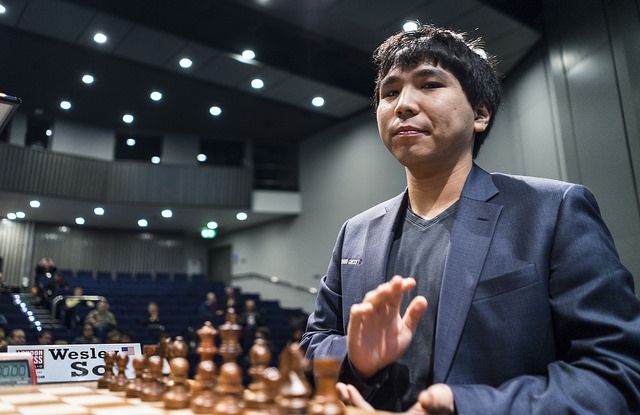
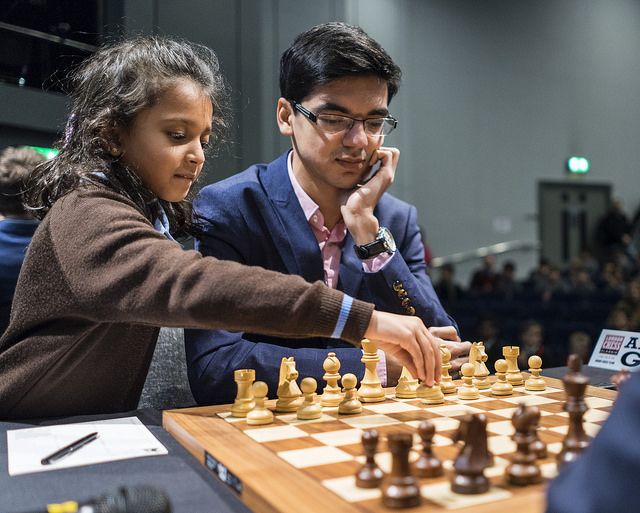
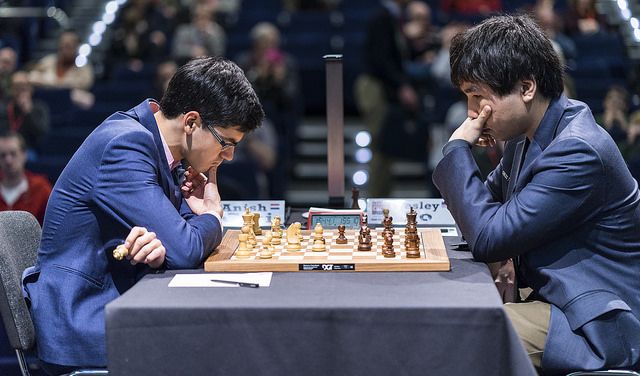
The Crazy Caro Kann
Veselin Topalov has shown his disinterest towards chess in recent years. Yet, he is invited to top tournaments. And he keeps showing decent performances. One of the reasons is that his chess understanding is quite excellent and he has a good idea of how to play the main opening systems. Hence, players like Caruana and Nakamura are trying to take him into uncharted territory by playing the French and Caro Kann and even unsound variations in them! Nakamura showed absolutely no fear and played the 3...c5 line in the Advance Caro Kann.

Although this is a respected system with well over five thousand games played, Nakamura played this only because he thought Topalov would not be well prepared. Playing this against someone like Caruana, So or Giri who work really hard on their openings would be a very dangerous decision.
[Site "London"]
[Date "2016.12.12"]
[Round "4"]
[White "Topalov, Veselin"]
[Black "Nakamura, Hikaru"]
[Result "0-1"]
[ECO "B12"]
[WhiteElo "2760"]
[BlackElo "2779"]
[Annotator "Sagar Shah"]
[PlyCount "106"]
[EventDate "2016.??.??"]
[EventType "tourn"]
[EventCountry "ENG"]
[SourceTitle "playchess.com"]
[Source "ChessBase"]
possibility in this position.}) 6. c3 e6 7. b4 (7. Be3 {is another main move.})
7... a6 (7... Nxe5 8. Qa4+ Nc6 9. Ne5 $18) 8. Nbd2 Nxe5 9. Qa4+ (9. Be2 $14 {
is possible.}) 9... Nd7 10. Ne5 Ngf6 11. c4 $6 (11. Nxg4 Nxg4 12. Be2 Nge5 13.
O-O {would be a normal way to play. But of course Veselin likes to spice up
things.}) 11... a5 $1 {Excellent move by Nakamura. Suddenly the entire
queenside fortifications fall apart.} 12. Nb3 axb4 13. Qb5 (13. Qxb4 Nxe5)
13... Be7 14. c6 bxc6 15. Nxc6 Qc7 16. f3 (16. Nxe7 Rb8 17. Qa5 Qe5+ 18. Be3
Kxe7 $17) 16... Bf5 17. Nxe7 Rb8 $1 {A nice intermediate move.} 18. Nxf5 $2 (
18. Qa5 Qe5+ 19. Kf2 Kxe7 $15) 18... Rxb5 19. Nxg7+ Ke7 (19... Kf8 {was also
pretty good.} 20. Nxe6+ fxe6 21. cxb5 Kf7 $17) 20. cxb5 {Materially White is
doing fine but in terms of development he is far behind and Nakamura takes
advantage of it.} Nc5 $6 (20... Qe5+ $1 21. Be2 Nc5 $19) 21. Bb2 $1 Nxb3 22.
axb3 {Now White can survive.} Qf4 23. Be2 $6 (23. Ra7+ Nd7 24. Nf5+ exf5 25.
Rxd7+ Kxd7 26. Bxh8 Qe3+ 27. Kd1 Qxb3+ 28. Kd2 Qa2+ 29. Kc1 $11) 23... Rc8 $1
24. Rd1 Qg5 (24... Rc2 $17) 25. b6 $2 (25. O-O Qxg7 26. Bd4 $15) 25... Rc2 26.
Bxf6+ Qxf6 27. Nh5 Qc3+ 28. Kf1 Qe3 29. Re1 Qxb6 {Black is winning because
white just cannot co-ordinate. The b3 pawn will fall and the Black pawn will
queen. The rest is easy.} 30. Nf4 Qe3 31. g3 Qxb3 32. Kg2 Kf8 33. Kh3 Qb2 34.
Rb1 Qf6 35. Rhe1 e5 36. Nxd5 Qe6+ 37. Kg2 Qxd5 38. Rxb4 Qd2 39. Rb8+ Kg7 40.
Kf1 Qh6 41. Kg2 e4 42. Rb3 Qe6 43. Re3 exf3+ 44. Kxf3 Qh3 45. Rd1 Qh5+ 46. Kf2
Qxh2+ 47. Kf3 Rc6 48. Rd4 Rg6 49. g4 Rf6+ 50. Ke4 Qh1+ 51. Kd3 Qb1+ 52. Kd2
Qb2+ 53. Kd3 Rc6 0-1
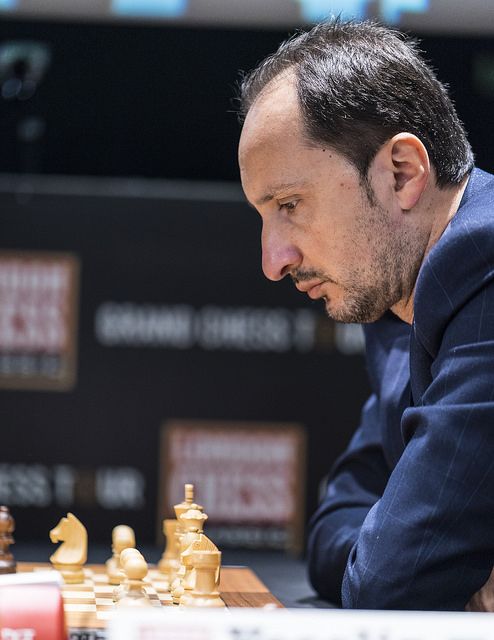

Can you guess the player?! #LondonChess pic.twitter.com/mbiuj6N8Jy
— Fiona Steil-Antoni (@fionchetta) December 12, 2016
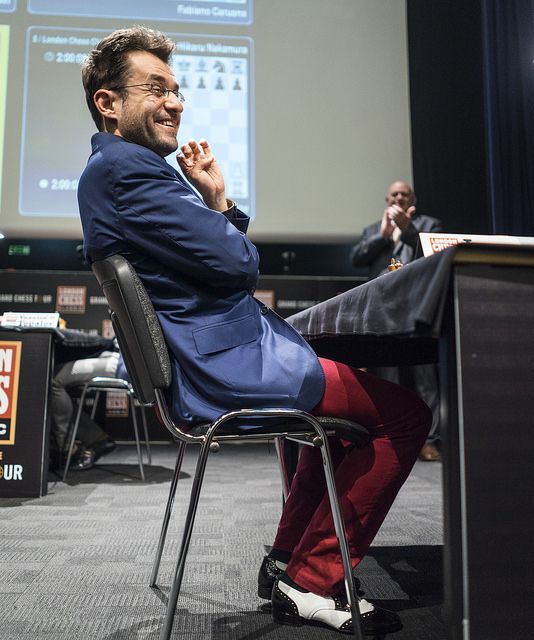
Aronian and the tea cup: a love story. #LondonChess pic.twitter.com/0GwZ3praf6
— Olimpiu G. Urcan (@OlimpiuUrcan) December 11, 2016
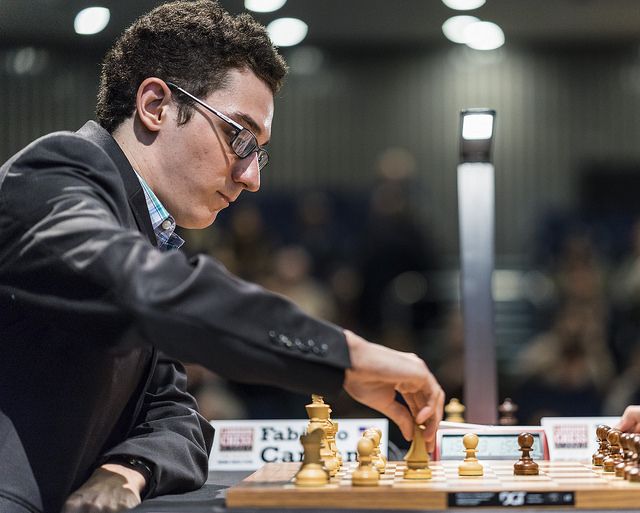
[Site "London"]
[Date "2016.12.12"]
[Round "4"]
[White "Caruana, Fabiano"]
[Black "Aronian, Levon"]
[Result "1/2-1/2"]
[ECO "C77"]
[WhiteElo "2823"]
[BlackElo "2785"]
[Annotator "ChessBase"]
[PlyCount "61"]
[EventDate "2016.??.??"]
[EventType "tourn"]
[EventCountry "ENG"]
[SourceTitle "playchess.com"]
[Source "ChessBase"]
1. e4 e5 2. Nf3 Nc6 3. Bb5 a6 4. Ba4 Nf6 5. d3 b5 6. Bb3 Be7 7. a4 b4 8. Nbd2
Bc5 9. Nf1 d6 10. Ng3 Nd4 11. Nxd4 Bxd4 12. O-O O-O 13. Rb1 Rb8 14. c3 Ba7 15.
d4 Be6 16. Bxe6 fxe6 17. Be3 bxc3 18. bxc3 Rxb1 19. Qxb1 Ng4 20. h3 Nxe3 21.
fxe3 Qg5 22. Kh2 a5 23. Rxf8+ Kxf8 24. Qb7 Bb6 25. Qc8+ Kf7 26. Qd7+ Qe7 27.
Qb5 g6 28. Nf1 Qg5 29. Nd2 Qxe3 30. Qd7+ Kf8 31. Qd8+ 1/2-1/2
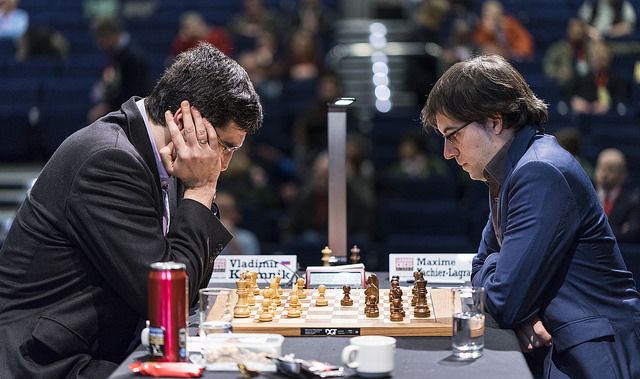
[Site "London"]
[Date "2016.12.12"]
[Round "4"]
[White "Kramnik, Vladimir"]
[Black "Vachier-Lagrave, Maxime"]
[Result "1/2-1/2"]
[ECO "A49"]
[WhiteElo "2809"]
[BlackElo "2804"]
[Annotator "ChessBase"]
[PlyCount "121"]
[EventDate "2016.??.??"]
[EventType "tourn"]
[EventCountry "ENG"]
[SourceTitle "playchess.com"]
[Source "ChessBase"]
1. d4 Nf6 2. Nf3 g6 3. g3 Bg7 4. Bg2 d5 5. O-O O-O 6. Nbd2 Nc6 7. b3 e5 8. dxe5
Ng4 9. c4 d4 10. Ne4 Ngxe5 11. Nxe5 Nxe5 12. Bg5 f6 13. Bc1 f5 14. Nc5 c6 15.
Bb2 Qd6 16. e3 Nxc4 17. Bxd4 Bxd4 18. Qxd4 Qxd4 19. exd4 Nd6 20. Rfd1 Nb5 21.
d5 Nc3 22. dxc6 Nxd1 23. Bd5+ Kh8 24. cxb7 Bxb7 25. Bxb7 Rad8 26. Ne6 Rfe8 27.
Nxd8 Rxd8 28. Kf1 Nc3 29. a3 Rb8 30. Rc1 Nb5 31. Rc8+ Rxc8 32. Bxc8 Nxa3 33.
Ke2 Nb5 34. Kd3 Kg7 35. Bd7 Nd6 36. f3 Kf6 37. Kd4 Nf7 38. Bb5 Ne5 39. Be2 g5
40. Kd5 h5 41. b4 Ng6 42. b5 f4 43. g4 hxg4 44. fxg4 Ne5 45. h3 f3 46. Bf1 f2
47. Ke4 Ng6 48. Ke3 Ke5 49. Bg2 Nf8 50. Kxf2 Kf4 51. Ke2 Kg3 52. Bf1 Ne6 53.
Ke3 Nf4 54. Ke4 Nxh3 55. Kf5 Nf2 56. Kxg5 Nxg4 57. Be2 Ne3 58. Kf6 Nd5+ 59. Ke5
Nc3 60. Bc4 Nxb5 61. Bxb5 1/2-1/2
Results of Round four
| Br. | Title | Name | Country | ELO | Res. | Title | Name | Country | ELO |
|---|---|---|---|---|---|---|---|---|---|
| 1 | GM | Anish Giri |
|
2771 | ½ - ½ | GM | Wesley So |
|
2794 |
| 2 | GM | Vladimir Kramnik |
|
2809 | ½ - ½ | GM | Maxime Vachier Lagrave |
|
2804 |
| 3 | GM | Fabiano Caruana |
|
2823 | ½ - ½ | GM | Levon Aronian |
|
2785 |
| 4 | GM | Viswanathan Anand |
|
2779 | ½ - ½ | GM | Michael Adams |
|
2748 |
| 5 | GM | Veselin Topalov |
|
2760 | 0 - 1 | GM | Hikaru Nakamura |
|
2779 |
Standings after round four
| Rk. | Title | Name | ELO | 1 | 2 | 3 | 4 | 5 | 6 | 7 | 8 | 9 | 10 | Pts. | Perf. | TB | |
| 1 | GM | Wesley So |
|
2794 | ½ | 1 | ½ | 1 | 3.0 / 4 | 2961 | |||||||
| 2 | GM | Levon Aronian |
|
2785 | ½ | ½ | ½ | 1 | 2.5 / 4 | 2882 | 5.00 | ||||||
| 3 | GM | Fabiano Caruana |
|
2823 | ½ | ½ | ½ | 1 | 2.5 / 4 | 2871 | 4.00 | ||||||
| 4 | GM | Vladimir Kramnik |
|
2809 | ½ | ½ | ½ | 1 | 2.5 / 4 | 2881 | 3.75 | ||||||
| 5 | GM | Hikaru Nakamura |
|
2779 | 0 | ½ | 1 | 1 | 2.5 / 4 | 2864 | 3.50 | ||||||
| 6 | GM | Anish Giri |
|
2771 | ½ | ½ | ½ | ½ | 2.0 / 4 | 2781 | 4.00 | ||||||
| 7 | GM | Viswanathan Anand |
|
2779 | ½ | 0 | 1 | ½ | 2.0 / 4 | 2788 | 3.25 | ||||||
| 8 | GM | Maxime Vachier Lagrave |
|
2804 | ½ | ½ | 0 | ½ | 1.5 / 4 | 2692 | |||||||
| 9 | GM | Michael Adams |
|
2748 | 0 | 0 | ½ | ½ | 1.0 / 4 | 2592 | |||||||
| 10 | GM | Veselin Topalov |
|
2760 | 0 | 0 | 0 | ½ | 0.5 / 4 | 2466 |
